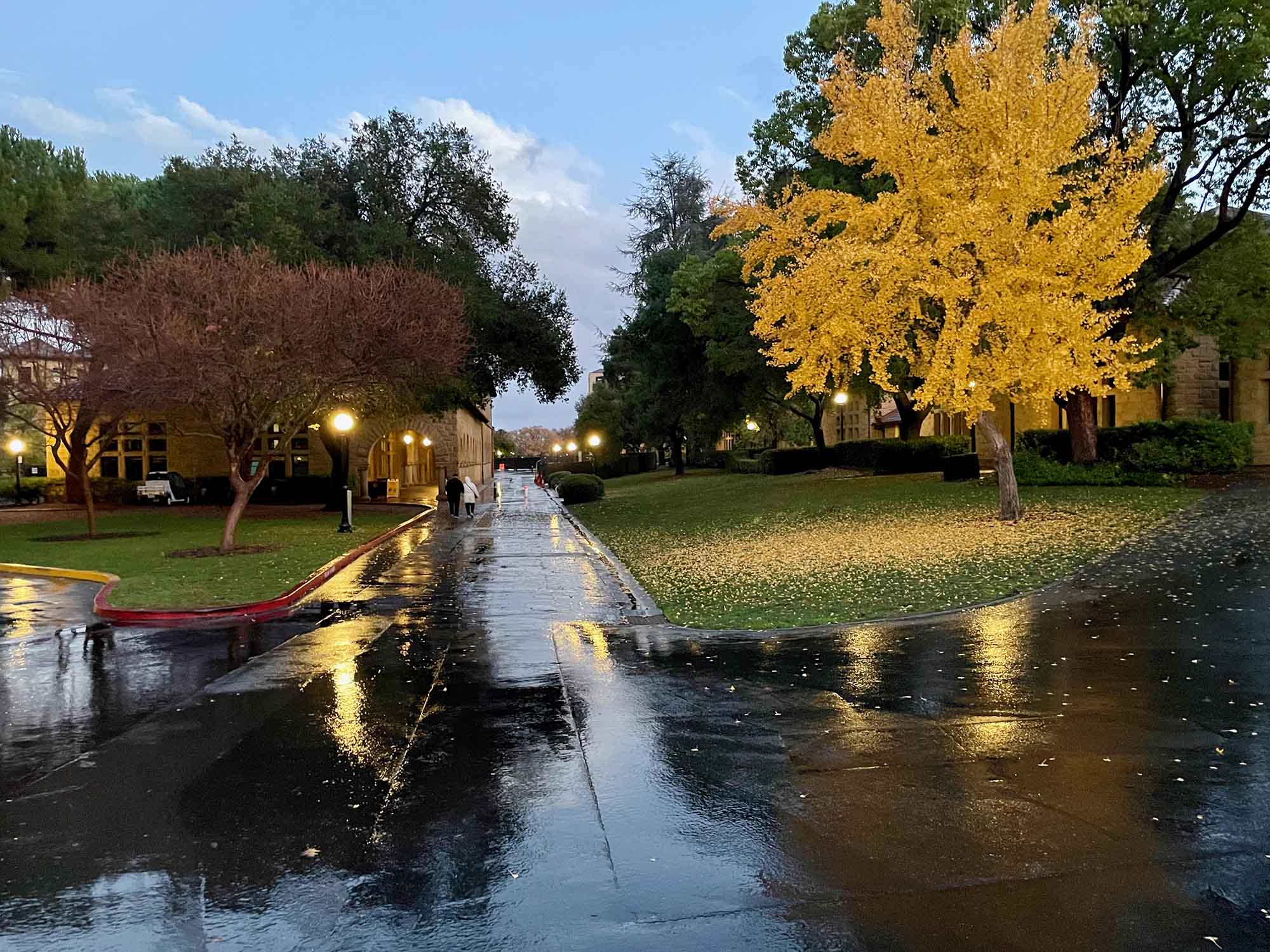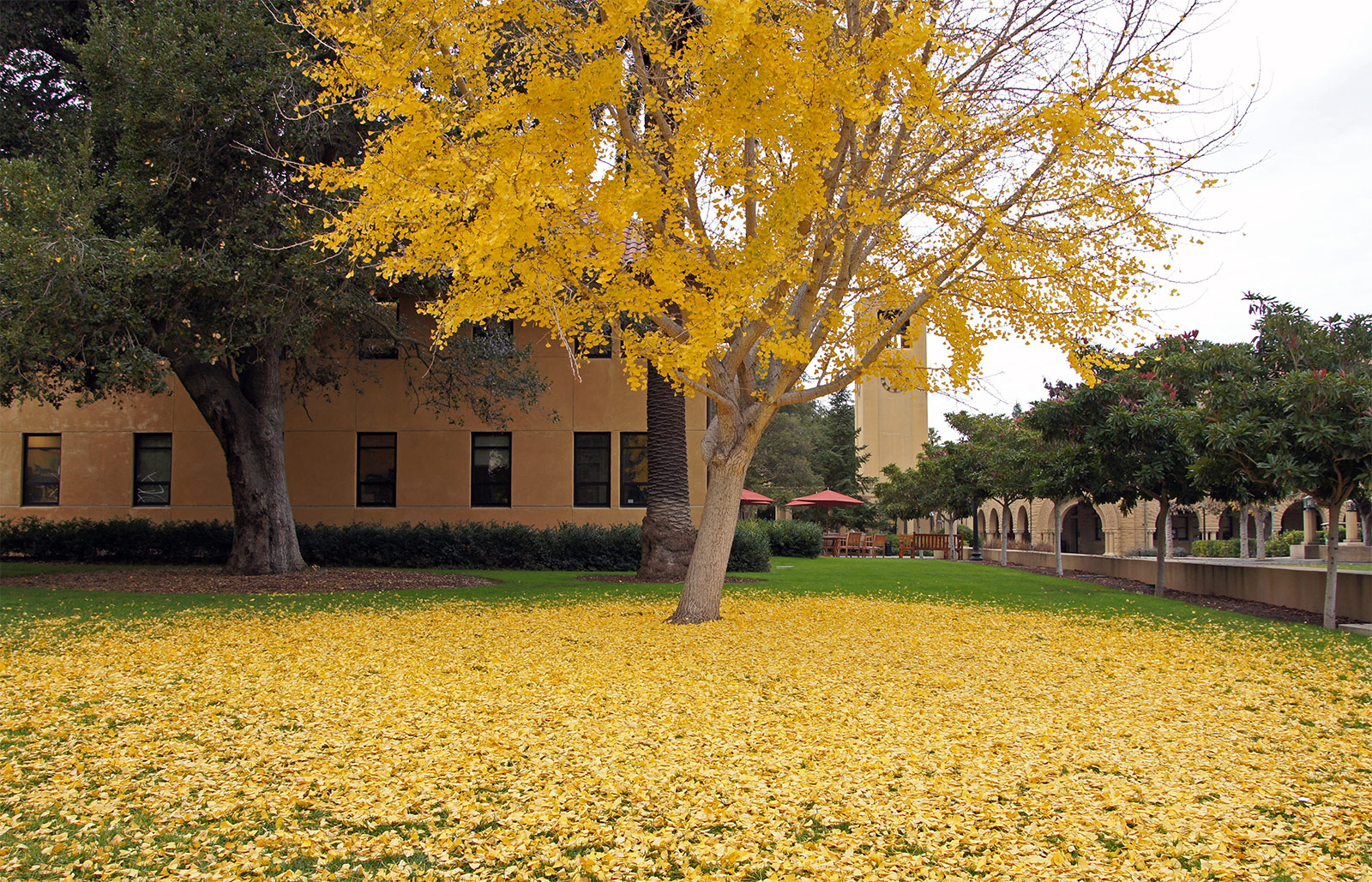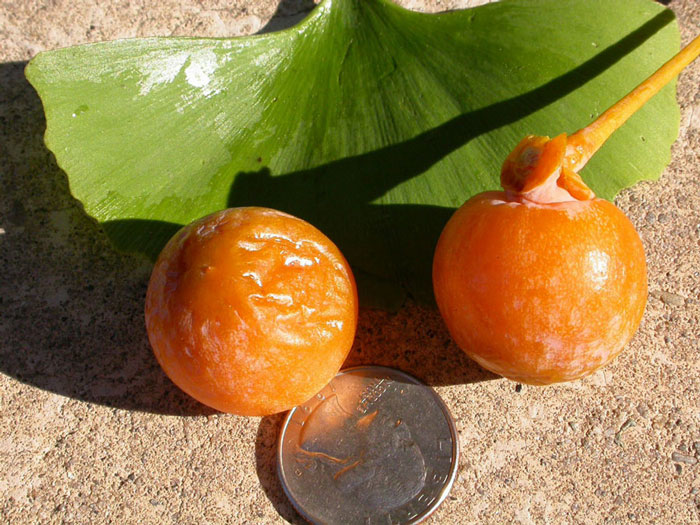Ginkgo biloba
 ginkgo, maidenhair tree
ginkgo, maidenhair tree

In the fall, the clearest pure yellow is seen displayed on the numerous maidenhair trees, every single one of which growing on campus can then be discovered with ease. Examination of the fan-shaped leaf suggests something a trifle unusual, apart from the resemblance of the shape to the maidenhair fern, and indeed the tree turns out to be a gymnosperm, having a naked, edible seed as with conifers, but antedating today’s conifers. The fallen fruit being messy and smelly, it is customary to plant only male clones.
The trees were planted in Chinese temple grounds from time immemorial for the edible kernels but for decades the only campus female was one in the thicket between the Faculty Club and Kingscote Gardens. Mayfield Avenue is planted with very attractive male ginkgos near Frenchman’s Road and there are more in many other locations. The tallest campus ginkgo is in the back of Ronald McDonald House. Three trees of variety ‘Fastigiata,’ planted summer 2003 by the SE entrance of CERAS, have not done well.
In Palo Alto, a beautifully shaped, mature specimen is between 1457 and 1459 Hamilton Avenue, and ginkgos line Greenwood Avenue between Hutchinson Avenue and Newell Road. A female is in the garden of The Museum of American Heritage at 351 Homer Avenue, near the wisteria-covered walkway.
The first in America date back to 1784 in Philadelphia, which was in those years the locus of American botanical interest. The ginkgo was brought by Engelbert Kaempfer in 1691 to Utrecht, where a tree from those days is still standing. For colorful and extremely charming and exhaustive background, including a photo of Goethe’s poem to a lady comparing himself to a ginkgo, see the website The Ginkgo Pages by Cor Kwant. The 2013 book Ginkgo: The Tree That Time Forgot by former Kew director Peter Crane has a wealth of information as well.

In the late eighties or nineties, 16 or more ginkgos appeared at the east end of Green Library and by 2001 half of them were bearing cherry-sized yellowish seeds – whether by carelessness or design. The thin layer of flesh, which has an astringent taste, encloses a single, thin-shelled, keeled pit with a satin finish and containing a two-toned kernel that is equally attractive in appearance. A 1½-inch stalk emerging from a leaf axil has two flowers that, by fall, may ripen as a pair, but half will ripen as singles. The female reproductive structure, technically not a flower, has no petals, no calyx, and no pistil – it is just a tiny ovary less than ¼ inch across, with a rounded surface and a nipple that is receptive to pollen. This is a truly primitive flower, with ancestry dating back to before the days of insects or other pollinators. The pollen-bearing cones (again, technically not flowers), which grow on separate male trees, have the form of catkins. With dioecious species such as the ginkgo, if you do not want fruit, you try to raise only male trees; on the other hand, if you want fruit, kiwi fruit for example, you need both males and females.
More commonly, flowers possess both male organs (anthers) that produce pollen and female organs (stigmas) that receive pollen; the ensuing seeds are then sheltered in an ovary. This seems like an economical plan, putting the key organs together, except that it tends to frustrate the fostering of genetic diversity resulting from attraction of insects or birds to carry pollen from one tree to another. Avoidance of self-pollination is a key feature of bisexual flowers; it is achieved by temporal, geometrical, or chemical means. A fig encloses over a thousand tiny flowers, male and female, but cross-fertilization is cleverly discouraged by delaying pollen release until the female flowers have passed beyond receptivity. Self-pollination may happen anyhow, and in some cases may be counted upon.
Ginkgo leaves give a glimpse of the origin of leaves as we know them today. There are no branching or anastomosing veins, just a few forks near the stalk. The leaf is clearly a bundle of stalk fibers, splayed out flat as in a fan with 80 or more veins, and terminating in a wavy edge without converging to an apex as everyday leaves do. Get a leaf of flax, a reed, and a palm leaflet, for close comparison with a leaf from the Green Library ginkgos.
Although the tree is native to China, where it is known, among other names, as yin hsing (silver apricot), the name ginkgo is from archaic Japanese gin-kyo. Fossil leaves are found in Asia, Australia, Europe, and America (as at the Ginkgo/Wanapum State Park on the Columbia River 30 miles east of Ellensburg, Washington) showing that the design dates back 150 million years.
Ginkgo biloba extract is a widely sold supplement, prepared in different ways by various manufacturers. The product does not come under the rules of the Food and Drug Administration and does not have to state on a label what the substance consists of, what the quantities or side-effects are, or what interactions are known to occur in conjunction with other dietary intakes or health conditions. It is not necessarily illegal to make unsubstantiated claims on the label. You may sue for false advertising and invite the Federal Trade Commission to investigate, but the FTC is not funded to seek out false advertising. Studies aimed at finding evidence for the effect of specified doses of particular supplements on individual diseases are under way, in many cases by the manufacturer.
Name derivation: Ginkgo – silver apricot in Chinese; biloba – two-lobed, in reference to the leaves.
About this Entry: The main text of this entry is from the book Trees of Stanford and Environs, by Ronald Bracewell, published 2005. McDonald House & Fastigiata locations were subsequently added by John Rawlings. Nov 2017: Added reference to Peter Crane book; Museum of American Heritage location of female (SP).




